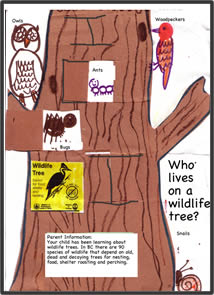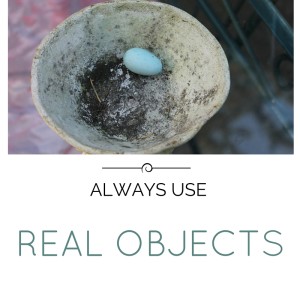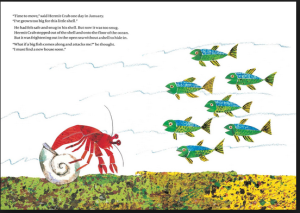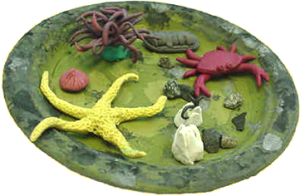If your experiences with teaching themes or unit topics has mostly been about handing out worksheets about the topic and having your students create identical crafts, try the 8 tips below to give your students opportunities to inquire, investigate, and practice math and science skills.
They will not only learn new skills but they will also gain a greater understanding of the unit topic.
Bringing items about specific topics into the classroom captures young children’s attention, and lead to further observations and inquiries.
Watch your students’ interest levels rise as they touch and explore objects. Magic moments begin to happen as one child’s enthusiasm influences other children.
Questions and wondering begins, playing with objects lead to occasions for comparisons, categorizing, creating collections and learning new vocabulary.
1. Choose the smaller part of a larger topic
This is important when teaching young children. Choose to teach about a tide pool, rather than the ocean, a wildlife tree rather than the forest, crayfish rather than rivers, your local community rather than a different country.
This allows the content of the research unit to be accessible, something to visit, touch, experience, rather than an abstract concept.
2. Choose to research topics from your local environment
Students can learn many concepts from your local school, parks and communities. Bring the children to actual places or to bring the real objects, things and animals into your classroom for the students to investigate.
I live on the west coast of Canada, have access to beaches and can bring a collection of limpets, mussels, chitin, crab and other shells (not alive!) into the classroom.

Wildlife trees are in the schoolyard. Field trips that are close by do not require a lot of driving or expense. If you are in a big city, investigate insects, leaves, puddles, parks.
3. Play is learning
Play is the work of children and it is through play that children make sense of the world around them.
The National Science Teachers Association defines scientific inquiry as “the diverse ways in which scientists study the natural world and propose explanations based on the evidence derived from their work.
Scientific inquiry also refers to the activities through which students develop knowledge and understanding of scientific ideas, as well as an understanding of how scientists study the natural world.”
This is the way young children naturally learn. They play, they try things, and they see what happens. Then they build their own understanding and assumptions about how the world works from their experiences, then they repeat the cycle.
Let children use the objects on the science observation table in other ways besides studying them with magnifying glasses.
Build vocabulary as the children play, “The shells you’re using for plates are called bivalves.” or “The rocks in that cup are shiny but the ones in that cup are dull.” or “You put quartz rocks in the red container.”
4. Allow time for skill practice
Plan for opportunities for literacy activities, science experiments, thinking skills and processes such as observing, classifying, measuring, recording and for learning scientific and math vocabulary. For example, if your topic is local schoolyard birds, collect or ask parents to collect feathers and bring them to class.
Compare lengths, widths, colors, patterns, then graph and count how many of each. Have the kids touch them and record their description words and share new vocabulary with them. Have children record their experiences, using drawings and emergent spelling. For an easy introduction into this process, check out my ebook, “Challenging Children to Investigate with Everyday Things”
5. Read non-fiction and fiction to the children about the topic
Spark student interest in the settings of fictional stories or non-fiction books. Eric Carle’s, “A House for a Hermit Crab”, presents content on the characteristics of the hermit crab and also introduces other sea creatures as the story progresses.
Follow up with an open-ended literature-based activities that allow the children room to share what they have learned during the topic study or theme. In this case, each child could create a page for a class book showing other animals that the hermit crab could have met on his journey.
6. Integrate other subject areas within the topic of research
Use art, music, and drama to introduce new information. The activities capture the children’s attention and reinforce new vocabulary. One year, while immersed in a pond study, I read the Princess and the Frog story to my students. One student drew and cut out the frog and taped a stick on the back. Soon more children were involved in puppetry, making theatres, and introducing other pond creatures into their plays and the enthusiasm from those children inspired the rest of the class.
I provided simple materials, such as gold paper to make crowns, scraps of lace and material, yarn for hair, popsicle sticks, lightweight card, small boxes for theatres, and recording booklets for their new stories. So much fun and so much learning going on without me directing the show!
7. Plan opportunities for students to communicate their knowledge
Plan for two to five children a day to talk about their pictures, models, or other accomplishments and to talk about what they have learned. Train the other children not to interrupt and have a short time for questions after each child’s turn. Don’t make this session too long and do some jumping jacks in between sharing if necessary!
8. Use projects to reflect the children’s new knowledge
Having the students create something to demonstrate their new knowledge helps you to quickly see what they have learned.
After investigating living tide pool animals, as well as dried shells in the classroom, the students made their own small tide pools. The students’ mini-tide pools and tide pool critters were made from sturdy paper plates, paint and modeling clay.
Ask them to create their favorite animals. Provide magnifying glasses for further observation and the samples of dried starfish, barnacles, limpets and other shells for the students to copy.
Children printed labels for some of the creatures, copying from the signs on the science center shelf. Other children printed what was significant to them about tide pools or I recorded their descriptions to place beside their tide pool displays.


